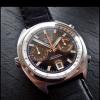-
Recently Browsing
- No registered users viewing this page.
-
Topics
-
Posts
-
An extremely skilful repair. Just look at the balance cock having all that piercing out. Do you know the date of the watch.
-
Wow @RichardHarris123, I didn't know you were a famous scientist! You are one of the authors, right? I watched this a few years ago. What I found interesting is the title of her presentation "how I stopped worrying about radium dials"...... BUT then she carries her watches in a lead-line bag!?!? Sounds like a contradiction to me. Personally (!!!!), I don't want to work on radium dials/hands. Which is a shame, because I love watches from the 1930s to 50s. Even when working on tritium dials, I wear a mask, wear cots (as always..), open the window, try to remove any loose lume with Rodico and then dispose of it, and wash my hands thoroughly. I assume that this level of precaution may be excessive (for Tritium), but I would think that it's the minimum when working on Radium. Especially a mask, I'd say, is essential to avoid inhaling any particles. I understand that's the main risk for Radium and its alpha radiation, which is harmless in a closed watch case with its crystal, but dangerous inside the body. I keep my watches, including one with a lot (!) of Radium on the dial and hands in a normal watch box -- I guess I should rather keep it in a well-ventilated area due to its Radon gas emissions. My approach is based on some researching on the topic + an innate fear of radioactivity (maybe based on my mother's stories of Chernobyl fallout/rain when I was a small child).
-
As promised I think I've included the most relevant dimensions but the paper is 1mm squared and the drawing is 1:1 so most of the information is there just by counting squares, but let me know if you need more detail. I have omitted the base for clarity. The frame is some aluminium alloy but the two guide rails, the threaded bolt, the threaded insert for the bolt, and the pusher plate are all steel. The pusher plate can be installed in either of two locations depending on whether you're installing or removing. Important to note that it has flats on it to lock its orientation to the frame. Also that the axes of the pusher and locating pins are different. Hopefully the drawing and the photos in my earlier post will give you all the info that you need. Have fun 🙂
-
Thank you for your introduction and welcome to this friendly forum. We all look forward to your contributions and continued involvement.
-








.thumb.jpg.cb17a66989f1e796fd4217db2e9ca9df.jpg)

Recommended Posts
Join the conversation
You can post now and register later. If you have an account, sign in now to post with your account.
Note: Your post will require moderator approval before it will be visible.